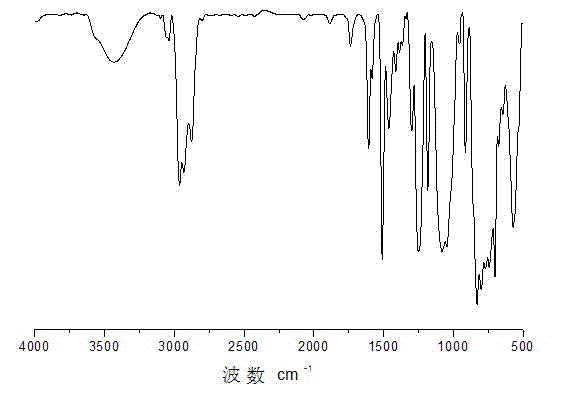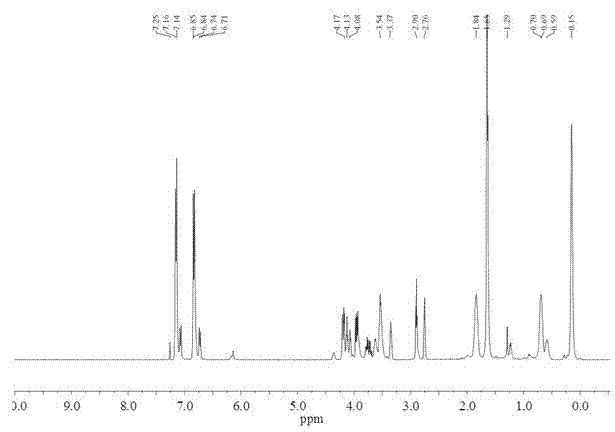Polysiloxane low polymer with side epoxy group and preparation method thereof
A technology of phenyltrialkoxysilane and polysiloxane, which is applied in the direction of silicon organic compounds, can solve problems such as ring-opening reactions of epoxy groups, and achieve mild reaction conditions, easy realization, and good thermal oxygen stability Effect
- Summary
- Abstract
- Description
- Claims
- Application Information
AI Technical Summary
Problems solved by technology
Method used
Image
Examples
Embodiment 1
[0024] Step 1. Add 0.08mol γ-chloropropylmethyldimethoxysilane, 0.1mol phenyltriethoxysilane, 116g Toluene, heat the reaction system to 85°C, add 17.5g of dilute hydrochloric acid with a mass fraction of 7% dropwise, after reacting for 5 hours, add 0.0108mol trimethylchlorosilane, continue the reaction for 3 hours, remove the water layer after cooling, and wash with saturated sodium sulfate Wash the toluene layer with an aqueous solution to neutrality to obtain a polychloropropylphenylsiloxane toluene solution, which is completely transferred to a 250ml four-neck flask equipped with a stirrer, a reflux condenser, a thermometer, and a dropping funnel;
[0025] Step 2, in another 250ml four-necked flask equipped with stirrer, reflux condenser, thermometer, feed N 2 , add 0.07mol bisphenol A, 0.14mol sodium hydroxide and 90g deionized water, heat up to 90°C, reflux reaction for 1.5h under stirring, and obtain bisphenol A sodium salt solution after cooling; the prepared bisphenol ...
Embodiment 2
[0031]Step 1. Add 0.02mol γ-chloropropylmethyldiethoxysilane, 0.1mol phenyltrimethoxysilane, and 96g toluene to a 250ml four-neck flask equipped with a stirrer, reflux condenser, thermometer, and dropping funnel , heat the reaction system to 85°C, add 14.4g of dilute hydrochloric acid with a mass fraction of 5% dropwise, and react for 8 hours, add 0.012mol hexamethyldisiloxane, continue the reaction for 3 hours, remove the water layer after cooling, and wash with saturated sulfuric acid Wash the toluene layer with sodium aqueous solution to neutrality to obtain a polychloropropylphenylsiloxane toluene solution, which is all transferred to a 250ml four-necked flask equipped with a stirrer, a reflux condenser, a thermometer, and a dropping funnel;
[0032] Step 2, in another 250ml four-necked flask equipped with stirrer, reflux condenser, thermometer, feed N 2 , add 0.02mol bisphenol A, 0.06mol potassium hydroxide and 81g deionized water, heat up to 80°C, reflux reaction for 1h ...
Embodiment 3
[0037] Step 1. Add 0.05mol γ-chloropropylmethyldiethoxysilane, 0.1mol phenyltrimethoxysilane, and 91g toluene to a 250ml four-neck flask equipped with a stirrer, reflux condenser, thermometer, and dropping funnel , heat the reaction system to 90°C, add 12.1 g of dilute hydrochloric acid with a mass fraction of 7% dropwise, and after reacting for 6 hours, add 0.003 mol of hexamethyldisiloxane, continue the reaction for 4 hours, remove the water layer after cooling, and wash with saturated sulfuric acid Wash the toluene layer with sodium aqueous solution to neutrality to obtain a polychloropropylphenylsiloxane toluene solution, which is all transferred to a 250ml four-necked flask equipped with a stirrer, a reflux condenser, a thermometer, and a dropping funnel;
[0038] Step 2, in another four-necked flask equipped with stirrer, reflux condenser, thermometer, add and feed N 2 , 0.05mol bisphenol A, 0.1mol sodium hydroxide and 108g deionized water, heated up to 100°C, reflux rea...
PUM
 Login to View More
Login to View More Abstract
Description
Claims
Application Information
 Login to View More
Login to View More - R&D
- Intellectual Property
- Life Sciences
- Materials
- Tech Scout
- Unparalleled Data Quality
- Higher Quality Content
- 60% Fewer Hallucinations
Browse by: Latest US Patents, China's latest patents, Technical Efficacy Thesaurus, Application Domain, Technology Topic, Popular Technical Reports.
© 2025 PatSnap. All rights reserved.Legal|Privacy policy|Modern Slavery Act Transparency Statement|Sitemap|About US| Contact US: help@patsnap.com



